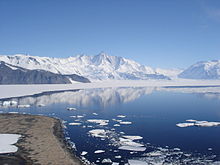International team of scientists reports on Antarctic lead pollution
Monday, August 4, 2014

Image: Andrew Mandemaker.
Researchers from Australia, Denmark, Germany, Norway, United Kingdom, and the United States conducted lead concentration measurements of sixteen ice core samples, and found that industrial air pollution has persisted Antarctica since its arrival there in 1889 and remains significant in the current century. Their study was published in Scientific Reports on July 28, and covered in Nevada's Review journal this Saturday.
Lead was chosen to trace the industrial pollution of atmosphere because of its low natural concentrations in ecosystems, as well as unique 'fingerprints' of different sources. Each lead ore deposit has its own distinct mixture of lead isotopes. Analysis of such characteristic isotopic signatures traced Broken Hill, Australia as the pioneering source of lead pollution in Antarctica, and even today its contribution remains significant. Coauthor Paul Vallelonga detailed, "Lead is a toxic heavy metal with strong potential to harm ecosystems [...] While concentrations measured in Antarctic ice cores are very low, the records show that atmospheric concentrations and deposition rates increased approximately six-fold in the late 1880s, coincident with the start of mining at Broken Hill in southern Australia and smelting at nearby Port Pirie". Lead author Joe McConnell noted, in Review journal, "A single industrial complex was enough to contaminate the entire continent of Antarctica thousands of kilometers away [...] We're still polluting Antarctica today".
McConnell said in getting the cores he traveled to Antarctica "four or five" times. Each of the drilled samples is about 4 inches (10 cm) across and 100–500 feet (30–150 m) long. They were cut for storage in boxes, six three-foot sections per box weighing over 100 pounds (450 kg). A single ice core can be used by researchers in many experiments during the next several years.
Concentrations of lead on the Antarctic continent have declined after the 1990s, but remain around three times higher than before industrialization, despite banning of leaded petrol and similar emissions regulations. As McConnell said, "Our measurements indicate that approximately 660 tonnes [1.5 million pounds] of industrial lead have been deposited on the snow-covered surface of Antarctic during the past 130 years [...] While recent contamination levels are lower, clearly detectable industrial contamination of the Antarctic continent persists today, so we still have a ways to go."
Support for the study came from, amongst others, the U.S. National Science Foundation Division of Polar Programs, WAIS Divide Science Coordination Office, Ice Drilling and Design and Operations, the National Ice Core Laboratory, Raytheon Polar Services, and the 109th New York Air National Guard.
Sources
- Henry Brean. "Nevada researcher reveals Antarctic’s dirty secret" — Las Vegas Review-Journal, August 2, 2014
- J. R. McConnell, O. J. Maselli, M. Sigl, P. Vallelonga, T. Neumann, H. Anschütz, R. C. Bales, M. A. J. Curran, S. B. Das, R. Edwards, S. Kipfstuhl, L. Layman, E. R. Thomas. "Antarctic-wide array of high-resolution ice core records reveals pervasive lead pollution began in 1889 and persists today" — Scientific Reports, July 28, 2014
- Justin Broglio, Maria-José Viñas. "Lead Pollution Beat Explorers to South Pole, Persists Today" — NASA, July 28, 2014
- Ross Edwards. "Our pollution reaches Antarctic long before the great explorers" — The Conversation (website), July 28, 2014



